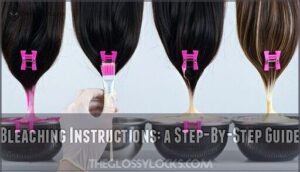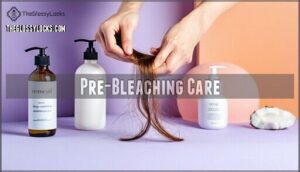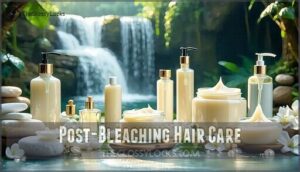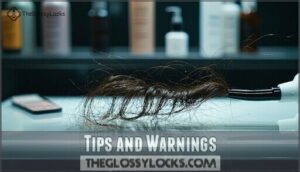This site is supported by our readers. We may earn a commission, at no cost to you, if you purchase through links.
 Hair stylists typically tell you to wait 4-6 weeks between bleaching rounds—your strands need time to recover from all that chemical stress.
Hair stylists typically tell you to wait 4-6 weeks between bleaching rounds—your strands need time to recover from all that chemical stress.
If you’ve got delicate or already-damaged hair, dermatologists bump that timeline to 8-10 weeks so your scalp can properly heal.
Your hair’s porosity level and previous chemical treatments play huge roles in determining the exact timeline—think of it like letting a wound heal before reopening it. Rushing the process can lead to irreversible damage that’ll leave you with hair that snaps like dried twigs.
The waiting game might test your patience, but your future self will thank you for taking the scenic route to your dream color.
Table Of Contents
- Key Takeaways
- What is Bleaching?
- What Are The Potential Harmful Effects of Bleaching Hair?
- How Long Should I Wait Between Bleaching Sessions?
- How to Bleach Your Hair
- Prepping Hair for The Second Bleaching Session
- Tips and Warnings
- How Much Time Should I Wait for Re-bleaching?
- Final Tips
- Frequently Asked Questions (FAQs)
- How long should you wait before bleaching your hair?
- Can I bleach my hair again after 24 hours?
- Is there a waiting period between bleaching appointments?
- How often should you wash your hair after bleaching?
- How long does it take for hair to heal after bleaching?
- Can I bleach my hair twice?
- What products should I use for bleaching my hair?
- Is bleaching my hair a permanent change?
- Are there home remedies for bleaching my hair?
- What is the best way to prepare my hair for bleaching?
- Conclusion
Key Takeaways
- Wait 4-6 weeks minimum between bleaching sessions to prevent severe hair damage and breakage – your hair needs time to rebuild its protein structure and restore moisture balance after chemical processing.
- Hair that’s fine, previously damaged, or chemically treated requires longer recovery periods of 8-10 weeks, as these conditions make strands more vulnerable to breakage and overprocessing.
- Bleaching causes permanent structural damage by stripping away natural proteins and moisture – rushing between sessions can lead to irreversible brittleness that won’t recover even with intensive treatments.
- Proper pre-bleaching preparation with deep conditioning and oil treatments, combined with post-bleaching care using sulfate-free products and protein treatments, determines whether your hair can safely handle another lightening session.
What is Bleaching?
Think of bleaching as your hair’s complete transformation—it’s like hitting the reset button on your natural color to create a blank canvas for whatever shade dreams you’re chasing.
Hair bleaching relies on hydrogen peroxide and ammonia working together to dissolve your natural melanin pigments, pulling color from each strand.
You’ll find different bleach formulations designed for various lightening levels, from subtle lifts to dramatic platinum transformations.
This bleach composition creates powerful bleach reactions that strip away color, but here’s the thing—it’s basically controlled damage. Your hair’s structure gets temporarily weakened as those chemical bonds break apart, which is why timing between sessions matters so much for keeping your locks healthy.
What Are The Potential Harmful Effects of Bleaching Hair?
Let’s be real about what bleaching does to your hair – it’s basically controlled damage. When you lighten your hair, you’re stripping away its natural proteins and moisture, leaving it vulnerable in ways that aren’t always obvious at first.
Hair breakage becomes your biggest enemy. Studies show 60% of people who bleach multiple times report significant breakage within just one month. Your strands lose about 45% of their strength, making them snap like brittle twigs when you brush or style.
Scalp irritation hits hard too. Nearly 15% of people experience burning, while over 90% with sensitive scalps deal with itching and redness. Some face chemical burns that can last days.
The moisture loss is brutal – 91% of bleached hair shows major moisture depletion. Your hair becomes a thirsty sponge that can’t hold water, leading to that straw-like texture nobody wants.
Most concerning? The irreversible effects. Over 65% of repeatedly bleached hair never fully recovers its original strength, even with intensive treatments. This is because bleach can damage the hair’s natural oils, leading to a loss of shine and a brittle texture.
How Long Should I Wait Between Bleaching Sessions?
Understanding waiting periods between bleaching sessions protects your hair from severe damage and breakage. Professional recommendations suggest waiting 4-6 weeks minimum, though the American Academy of Dermatology advises 8-10 weeks for best scalp health impact. Your hair’s condition determines the exact timeline—fine or damaged hair needs longer recovery. The process of bleaching can disrupt the hair’s structure, making it essential to follow these guidelines.
Several things affect how long you should wait between bleaching sessions:
- Hair porosity levels – highly porous hair absorbs bleach unevenly
- Previous chemical treatments – adds 2-4 weeks to recovery
- Scalp sensitivity – irritation requires extended healing time
- Overall hair strength – brittle strands need more repair time
You’ll know your hair is ready for another bleach session when it feels bouncy again and looks smooth instead of rough.
Stylists see way more breakage when people don’t wait at least two weeks—almost half more damage actually happens. Between sessions, stick with deep conditioners and protein masks since your hair slowly gets back about 12-18% of the moisture it lost.
How to Bleach Your Hair
Now that you know the timing, let’s walk through the actual bleaching process step by step.
Getting your materials ready and following proper technique can make all the difference between salon-quality results and a hair disaster.
Get The Materials Ready
Imagine this: you’re about to transform your hair, but first you need to gather your bleaching arsenal like a beauty warrior preparing for battle.
You’ll need bleach powder, volume developer (20 or 30 volume works for most hair types), a mixing bowl, application brush, gloves for protection gear, clips, and a strand test kit. Don’t forget foil if you’re doing highlights!
Bleaching Instructions: a Step-By-Step Guide
Ready to dive into the actual bleaching process without turning your hair into straw? Here’s your roadmap to safer bleach application techniques that’ll help you avoid those dreaded banding issues.
Always start with a strand test—it’s your crystal ball for timing bleach processing. Mix your volume developer with bleach powder in a 1:2 ratio, following manufacturer instructions for mixing bleach safely.
Here’s how to bleach your hair step by step:
- Section your hair properly – Create four quadrants using clips for even coverage
- Apply from mid-lengths to ends first – Never start at roots, they process faster
- Work quickly but carefully – Complete each section within 10 minutes
- Monitor constantly – Check every 10-15 minutes for desired lightness
- Rinse with cool water – Hot water opens cuticles further, causing damage
Sectioning hair properly prevents uneven results, while proper timing prevents overprocessing. Consider bleaching alternatives like high-lift color if your hair shows signs of weakness. Remember, factors affecting bleaching include your hair’s porosity and previous chemical treatments.
Prepping Hair for The Second Bleaching Session
Getting your hair ready for round two isn’t just about waiting—it’s about actively nursing it back to health.
You’ll need to focus on both pre-bleaching prep and post-bleaching recovery to keep your strands strong enough for another lightening session.
Pre-Bleaching Care
Think of your hair like a marathon runner who just crossed the finish line—it needs proper prep time before the next big race. Your damage assessment starts with checking hair elasticity by gently stretching a strand. Healthy hair bounces back; damaged hair snaps or stays stretched.
Focus on rebuilding hair strength through deep conditioning treatments twice weekly. Coconut oil applied overnight works wonders for restoring moisture balance and protecting your hair’s structure. Your scalp health matters too—avoid harsh styling and give irritated areas time to heal.
Test your hair porosity by dropping a clean strand in water. If it sinks quickly, your hair’s overly porous and needs protein treatments to fill those gaps. Different hair types require different prep times—fine hair needs gentler care than coarse strands.
Check your hair condition honestly. If it feels brittle, looks dull, or breaks easily when brushing, postpone that second bleaching session. Your hair health isn’t worth rushing the process.
Post-Bleaching Hair Care
Your hair just went through a chemical marathon, and now it’s time to nurse those strands back to health. Think of hair recovery after bleaching like physical therapy—your strands need gentle, consistent care to rebuild their strength. The importance of hydration can’t be overstated here.
Here’s what your hair needs most right now:
- Deep conditioning treatments twice weekly to restore moisture and elasticity
- Protein treatments monthly to rebuild the hair’s internal structure and prevent breakage
- Bond builders like Olaplex to repair damaged chemical bonds within each strand
Switch to sulfate-free shampoos immediately—these harsh detergents will strip away what little moisture your hair has left. When styling, heat protection becomes non-negotiable. Your damaged cuticles can’t handle additional thermal stress without proper barriers.
This hair care after bleaching phase determines whether your next session succeeds or fails. Hair damage repair takes patience, but consistent deep conditioning and protein balance will prepare your strands for round two.
Tips and Warnings
Bleaching your hair is like performing surgery on every single strand – one wrong move and you’re dealing with the consequences for months. That’s why recognizing damage signs early can save your hair from disaster. Professional advice always trumps DIY guesswork when dealing with bleach sensitivity or severe breakage.
What you need to know to keep your hair safe:
- Wait 4-6 weeks minimum between sessions to prevent hair damage from bleaching
- Watch for brittleness, excessive dryness, or snapping strands as clear damage signs
- Consider gradual lightening with alternative options like highlights instead of full bleaching
- Factors influencing waiting time include hair porosity, previous treatments, and scalp condition
- Stop immediately if you notice increased breakage – bleaching hair too soon causes irreversible damage
Safe bleaching practices mean listening to your hair’s needs, not your timeline.
How Much Time Should I Wait for Re-bleaching?
Patience becomes your hair’s best friend in safe bleaching practices. Professional Guidelines recommend waiting at least 4-6 weeks between sessions, though Damage Severity can extend this to 8-10 weeks. Your waiting period depends on several Bleach Timing Factors that influence your hair’s recovery.
What affects how long you should wait:
- Scalp Sensitivity – Irritated or tender scalps need extra recovery time
- Regrowth Impact – Natural growth provides fresh, unprocessed hair to work with
- Previous damage – Brittle or overly porous hair requires longer breaks
- Desired lightness level – Dramatic color changes need more sessions spaced further apart
Bleaching hair too soon creates uneven color and increases breakage risk markedly.
Final Tips
Ready to lock in those gorgeous results and keep your hair healthy for the long haul? These final tips will help you master safe bleaching while avoiding costly damage control mistakes.
- Respect the waiting period – Never bleach twice within 4-6 weeks, no matter how tempting.
- Monitor hair recovery – Check for elasticity and smoothness before your next session.
- Explore bleach alternatives – Consider highlights or toner-only touch-ups between sessions.
- Maintain your hair care routine – Deep condition weekly and use protein treatments.
- Seek professional advice – A colorist can assess readiness and prevent hair breakage.
Remember, patience pays off with healthier hair and better color results. Your hair maintenance efforts today determine tomorrow’s bleaching success.
Frequently Asked Questions (FAQs)
How long should you wait before bleaching your hair?
Between bleaching sessions, your hair needs at least four to six weeks for proper bleach recovery.
This waiting period allows damaged strands to rebuild strength and prevents severe hair damage from back-to-back treatments.
Can I bleach my hair again after 24 hours?
No, twenty-four hours is way too soon for another bleach session. Your hair needs at least four to six weeks between treatments to prevent serious hair damage, breakage, and bleach overlap that leads to uneven color correction.
Is there a waiting period between bleaching appointments?
Ironically, rushing to your next bleaching appointment might leave you with less hair than you started with.
Yes, there’s absolutely a waiting period between bleaching sessions—your hair needs time for bleach recovery to prevent severe hair damage and breakage that compromises overall hair health.
How often should you wash your hair after bleaching?
The golden rule for hair wash frequency after bleaching? Less is definitely more. Your freshly bleached strands need time to rebuild their hair moisture balance, so washing every 2-3 days prevents stripping away precious oils while supporting bleach damage repair.
Time to map out your washing strategy:
- Use sulfate-free shampoo – Gentle Shampoo Tips include choosing products that won’t further compromise your hair’s weakened cuticles
- Cool water rinses – Hot water opens cuticles and strips moisture, while cool water seals them shut
- Focus on scalp, not lengths – Your ends are the most damaged, so concentrate cleansing efforts on your roots
- Deep condition weekly – Hair care after bleaching demands intensive moisture treatments to restore elasticity
- Skip day-one washing – Give your hair 48-72 hours to settle before that first post-bleach shampoo session
Remember, your hair health maintenance routine directly impacts how well you’ll handle future bleaching sessions. Proper hair moisture balance now means shorter waiting periods between sessions later.
How long does it take for hair to heal after bleaching?
Your hair’s healing journey after bleaching usually takes 4-6 weeks, though the timeline varies based on your hair’s condition and damage level. During this Hair Recovery Time, your strands work to rebuild their protein structure and restore moisture balance.
How long your hair takes to heal really depends on a few key things:
| Recovery Stage | Timeline | What’s Happening |
|---|---|---|
| Immediate (1-7 days) | Week 1 | Cuticles begin closing, initial moisture restoration |
| Active Repair (2-4 weeks) | Weeks 2-4 | Protein rebuilding, elasticity returns, reduced breakage |
| Full Recovery (4-6 weeks) | Weeks 4-6 | Hair regains strength, natural oils rebalance |
Hair damage from bleaching affects your hair’s porosity and protein bonds. Post Bleach Care with deep conditioning treatments and bond-building products accelerates the hair repair process. Your Hair Regrowth Rate of about half an inch monthly means new, undamaged hair emerges during this waiting period.
Signs your hair health is improving include restored elasticity, reduced hair breakage, and smoother texture. If your hair still feels brittle or snaps easily after six weeks, extend the waiting period before considering another bleaching session.
Can I bleach my hair twice?
Yes, you can bleach your hair twice, but safe rebleaching requires patience. Hair recovery from bleach damage needs four to six weeks minimum between sessions.
Double bleaching without an adequate waiting period causes severe hair breakage and compromises your hair’s structural integrity completely.
What products should I use for bleaching my hair?
When selecting bleaching products, quality matters more than price. Professional-grade bleach kits deliver consistent results while protecting your hair’s integrity during the lightening process.
You’ll want to grab these key bleaching products:
- Bleach Kits with hydrogen peroxide and quality developers (like L’Oreal Paris Feria Hyper Platinum for up to 8 levels of lift)
- Hair Toners and color depositors to neutralize unwanted brass and yellow tones after bleaching
- Bond Repairers like Olaplex treatments that rebuild broken hair bonds during chemical processing
- Sulfate-free shampoos and deep conditioning masks to maintain moisture balance post-bleach
Pre-bleaching preparation includes avoiding heat styling tools and applying protective coconut oil the night before. This creates a barrier that shields your hair from excessive damage.
Post-bleaching care requires gentle cleansing with sulfate-free products, regular deep conditioning treatments, and bond-building toners. These steps help your hair stay healthy between bleaching sessions while maintaining your desired color results.
Is bleaching my hair a permanent change?
Absolutely, bleaching creates permanent Hair Color Reversal that won’t wash out. This chemical process permanently breaks down your hair’s natural pigment structure, causing Permanent Damage to the hair shaft.
While Color Fading might occur over time and Hair Regrowth will show your natural color, the bleached sections remain forever changed until cut off.
Are there home remedies for bleaching my hair?
While natural bleach alternatives like chamomile tea, lemon juice, and honey can gently lighten hair, they won’t deliver dramatic results like professional bleach.
These DIY hair whitening methods require patience and won’t cause the same hair damage as harsh chemicals.
What is the best way to prepare my hair for bleaching?
Think of your hair as a canvas before an artist begins painting. Preparation makes all the difference between a masterpiece and a mess. Start with hair conditioning using coconut oil overnight, then deep conditioning treatments to boost moisture balance and hair health. Skip heat styling tools completely, and perform elasticity tests by gently stretching a strand to assess hair porosity before any pre-bleach steps begin.
- Oil treatment – Apply nourishing coconut oil 12-24 hours before bleaching
- Deep conditioning mask – Use protein-rich treatments for damage repair and hair treatment
- Heat styling break – Avoid all hot tools for 48 hours to preserve hair repair progress
Conclusion
Think of your hair like a canvas—you wouldn’t paint over wet paint and expect masterpiece results. Knowing how long to wait between bleaching hair sessions isn’t just good advice, it’s essential for keeping your strands strong and healthy.
Just like you wouldn’t paint over wet paint, waiting 4-6 weeks between bleaching sessions protects your hair’s strength and health
Those 4-6 weeks aren’t just downtime, they’re your hair’s recovery period. Trust the process, follow professional timing guidelines, and you’ll achieve that dream color without sacrificing your hair’s integrity.
- https://m.unice.com/blog/how-long-should-wait-when-bleaching-hair/
- https://holisticenchilada.com/how-often-can-you-bleach-your-hair/
- https://www.lorealparisusa.com/beauty-magazine/hair-color/hair-color-application/how-long-to-leave-bleach-in-hair
- https://pmc.ncbi.nlm.nih.gov/articles/PMC11652465/
- https://www.sciencebuddies.org/science-fair-projects/project-ideas/MatlSci_p020/materials-science/hair-bleaching-damage












